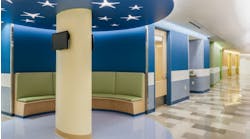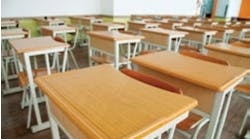When acoustics are mentioned with regard to schools, many people first think of performing arts. Classrooms often get the short shrift when it comes to designing a space that allows for optimum hearing conditions for students and speaking conditions for teachers. But over the last few years, increasing concern from state regulators and facility designers has focused greater attention on improving acoustics. The main acoustical issues to consider are low background (HVAC) sound, controlled room reverberation and isolation from sounds in adjacent rooms and other exterior noise.
Classroom acoustics became a more pressing matter as building designs emphasized energy conservation and shifted to more hermetically sealed building envelopes. This “sealing” of the building requires more extensive mechanical systems, which can elevate the level of background sound in the classroom, especially given the cost-effective solution of choice — the unit ventilator. When noise from computers and other equipment is added to this mix, schools end up with background sound levels that are too high.
The effects of poor classroom acoustics are varied. Beyond the obvious problem that students (especially young children or students with hearing impairments) can't properly hear or understand a teacher's words, another significant issue is that many teachers can get hoarse trying to project their voices to the back of a classroom. Some studies have reported an average loss of two days per teacher per year for voice-related health issues.
More ominous is the effect poor acoustics has on student learning. Many students strain to hear a teacher's voice and some, given the level of effort required, opt to tune it out completely. Conversely, several studies suggest that when classrooms have a better balance of lower background sound and good distribution of a teacher's voice, test scores rise significantly.
Setting standards
Some agencies are placing a greater focus on classroom acoustics, to the point where a state can withhold funding unless new schools meet acoustical requirements for background sound, room acoustics and sound isolation.
Four years ago, the American National Standards Institute (ANSI) issued standard S12.02-2002. It outlines acceptable design practices and specific criteria for classroom acoustics. The standard calls for limiting the background (mostly HVAC) sound in a classroom to 35 decibels (dBA). The desired outcome is to have a minimum differential (signal to noise ratio) of 15 decibels between a teacher's speech sound level and background noise.
Although the recommendations provide a desirable target, the real-world application of the ANSI standard has been challenging, especially for older schools and especially with regard to HVAC sound. This is because the standard requires that the maximum 35-decibel level be achieved almost everywhere in the classroom. In rooms with cabinet-style unit ventilators near student seating, the standard essentially is unattainable. Studies of existing classrooms have shown that many do not meet the low- background-sound standard or sound-isolation standards, and some do not meet the reverberation standards.
The ANSI S12.02 standard is made up of three main points:
- Overall room acoustics
Is the room too reverberant? Most schools now meet this criterion or can be modified to do so. Because excessive reverberation problems are recognized easily, most schools already have fixed this type of problem.
- Sound isolation
Are students in a classroom subjected to noises from from exterior sources? Most existing schools do not provide the levels of sound and impact (footfall, etc.) isolation that ANSI S12.02 requires, especially in the area of pass doors between classroom spaces. The construction required to provide sound isolation is fairly straightforward, but adds to costs.
- Low background (HVAC) sound levels
The third requirement, a 35-decibel ambient background sound level in a classroom, requires more care in design and is more expensive compared with a localized approach such as unit ventilators. In most cases, the standard is difficult to meet without significant expenditures. Some school projects are installing fully ducted systems that meet the low background sound requirements.
The most significant source of HVAC sound in a classroom typically is a unit ventilator or other localized fan device. In most cases, a unit ventilator cannot meet the ANSI standard. Sometimes a system can be over-designed so the unit always runs at low speed, and in this case, some areas toward the center of the room reach 35dBA. But near the floor-mounted unit, the sound typically rises to 40dBA or higher.
In many areas of the country, ANSI S12.02 already has had an effect. New Hampshire made it mandatory for new construction in 2004, and Connecticut followed suit in 2005. If a school project does not meet the standards, it will not get state funding. Massachusetts created its own standard that incorporates some of the ANSI goals.
The Collaborative for High Performance Schools (CHPS) standards for school construction also include requirements for acoustics. The major difference between CHPS requirements and ANSI S12.02 is that the CHPS standard gives more leeway and is more realistic for projects that can't afford fully ducted HVAC systems. It states that 35 decibels for background sound is optimum, but 40 decibels is acceptable, and even 45 decibels can be tolerated. The goal — creating that optimum 15-decibel differential — is the same, but the CHPS standards are more flexible and cost-sensitive than ANSI S12.02.
The majority of classrooms don't meet the ANSI standards, and because of the costs involved, most schools won't be upgrading these spaces anytime soon. Even when a classroom has poor acoustics and doesn't meet the S12.02 criteria, it still can be functional, so administrators don't feel pressure to correct problems.
For those institutions building or considering a new school, administrators need to be more demanding. They need to be aware, and make sure the design team is aware, of the instructional benefits of good acoustics.
Because some type of fully ducted HVAC system may be the only way to meet the letter of ANSI S12.02-2002, the goal of building classrooms with excellent acoustic qualities can become a significant financial burden. But creating an acoustically balanced classroom is a critical part of a well-designed and successful education facility.
McKeon, AIA, LEED AP, is vice president of Kaestle Boos Associates, an architectural firm with offices in New Britain, Conn., Foxborough, Mass., and Portsmouth, N.H. Berry, ASA, is a principal consultant for Cavanaugh Tocci Associates, Sudbury, Mass., an acoustical consulting firm.
Can you hear me now?
One option being explored to help meet the optimum signal-to-noise differential in the ANSI standard is the use of audio-enhancement systems for the teacher and students.
Ceiling- or wall-mounted speakers can amplify a teacher's voice evenly throughout a classroom so every student hears it clearly.
With these systems, teachers no longer have to raise their voices to reach students and are able to use conversational tones in dialogues with students. Some manufacturers assert that their systems reduce teacher absences because of fewer voice problems and that discipline issues drop because students respect the protocol of passing around a microphone in class rather than shouting out.
Brigham Young University, Provo, Utah, did a study that showed a rise in test scores and decreased absenteeism in a system with an audio-enhancement system. However, the systems have some negatives. First, they do nothing to address the ANSI standard of 35-decibel background noise. And second, the Acoustical Society of America recently issued a position paper outlining its opposition to the routine use of sound amplification in small, mainstream classrooms.
NOTABLE
35
The desired maximum number of decibels of background noise for school classrooms.
Source: American National Standards Institute, standard S12.02-2002

